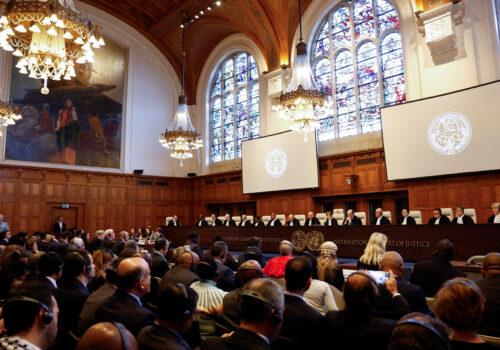The United States is unprepared for this nightmare scenario
It’s hard to disagree with former Secretary of Defense Robert Gates’s argument that the United States is confronting the greatest threat to global order that it has “in decades, perhaps ever”—with intractable wars in Europe and the Middle East and tensions that could easily escalate in Asia.
What I’ve tried to do in this column is find the best ways to understand the perils and (where possible) provide the best ideas for solutions. If you’re in search of more works of diagnosis—especially ones with rich historical perspective—read every word of Hal Brands’s “The Next Global War,” hot off the press at Foreign Affairs.
He usefully looks back on the runup to World War II, long before US involvement in that conflict, which saw the “aggregation of three regional crises: Japan’s rampage in China and the Asia-Pacific; Italy’s bid for empire in Africa and the Mediterranean; and Germany’s push for hegemony in Europe and beyond.”
Fast forward to today.
We also face three perilous regional challenges and autocratic powers who are growing dangerously close to each other, also unified mostly by their determination to blow up the status quo. China wants to replace the United States as the leading global power and push it out of the western Pacific; meanwhile, Russia wants to retake territory and influence lost with Soviet collapse, most immediately in Ukraine. In the Middle East, Iran and its proxies (among them Hamas, the Houthis, and Hezbollah) are bent on the annihilation of Israel and are struggling for regional dominance against Gulf monarchies and the United States. This struggle was on display most recently when an Iran-backed militant group launched a drone attack on a US base in Jordan this weekend, killing three US troops and injuring dozens.
“Beijing, Moscow, and Tehran,” writes Brands, “are the new ‘have not’ powers, struggling against the ‘haves’: Washington and its allies.”
Also in an echo of the present, the fascist countries that eventually teamed up as the Axis powers during World War II at first “had little in common except illiberal governance and a desire to shatter the status quo.” In 1937, US President Franklin D. Roosevelt called what was unfolding, long before Washington joined the war, an “epidemic of world lawlessness.”
Brands is a sophisticated thinker, and he draws nuanced comparisons—instead of leaping to conclusions. “But thinking through the nightmare scenario is still worthwhile,” he writes, “since the world could be as little as one mishandled crisis away from pervasive Eurasian conflict—and because the United States is so unprepared for this eventuality.”
Frederick Kempe is president and chief executive officer of the Atlantic Council. You can follow him on Twitter: @FredKempe.
This edition is part of Frederick Kempe’s Inflection Points Today newsletter, a column of quick-hit insights on a world in transition. To receive this newsletter throughout the week, sign up here.
Further reading
Fri, Jan 26, 2024
Experts react: What the International Court of Justice said (and didn’t say) in the genocide case against Israel
New Atlanticist By
South Africa asked the court to order an immediate cease-fire. Israel asked the court to throw out the case. Atlantic Council experts explain what the court did instead.
Thu, Jan 25, 2024
The Fed is falling behind as other central banks leap ahead on digital currencies
New Atlanticist By Josh Lipsky, Ananya Kumar
And the innovation gap is not just on CBDCs. FedNow, the long-awaited interbank settlement system, has taken years longer than comparable systems in Europe.
Thu, Jan 25, 2024
Houthi attacks in the Red Sea hurt global trade and slow the energy transition
New Atlanticist By William Tobin, Joseph Webster
Recent attacks on commercial shipping in the Red Sea are a reminder that a major disruption to freedom of navigation would hold many negative consequences.
Image: Visitors tour the World War II Memorial at night with the Washington Monument in the background in Washington, May 27, 2004. The memorial, which will be dedicated on May 29, honors the 16 million U.S. servicemen the more who served during World War II the more than 400,000 who died, and the millions who supported the war effort from home. REUTERS/Molly Riley MR


